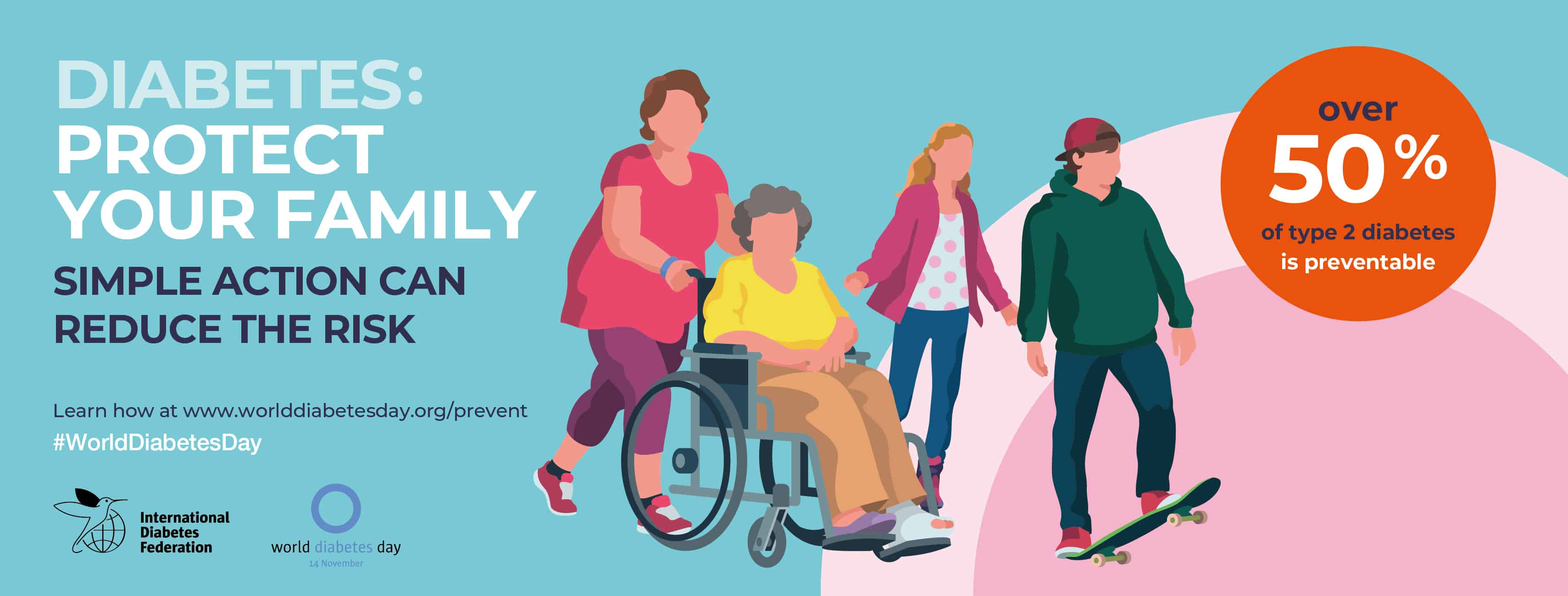Diabetes Australia estimates that 1.7 million Australians have diabetes. There are several forms of diabetes, with Type 2 Diabetes being the most common – it accounts for up to 90% of diabetes. In people with Type 2 Diabetes, the body still produces insulin but it may not be enough to meet the body’s demands or the body may be resistant to the insulin produced. It can be a chronic disease that requires ongoing management and monitoring. Type 2 Diabetes is the leading cause of blindness and kidney failure in adults, and is a major contributor to the obesity epidemic.
For the second year running, the International Diabetes Federation (IDF) have used the theme of ‘Family’ to promote World Diabetes Day,to focus on the impact of diabetes not only on the individual but also on those nearest and dearest. Recently the IDF found that even when there is a family member with diabetes in the household, people struggle to recognise the early signs and symptoms of diabetes in their own children. This is concerning as diabetes can run in families due to either genetics and/or shared environment risk factors such as, diet and exercise levels. Furthermore, Type 2 Diabetes can be prevented in some cases by modifying these shared lifestyle factors (Diabetes Australia, 2019). Supportive family units can be a catalyst for change and can led to better management of the disease.
A new diagnosis of diabetes comes along with a great deal of education and instruction on how to modify your diet, how to monitor blood glucose levels and the importance of increasing your exercise levels. There is also the realisation that medication is required and lifestyle changes need to be lifelong to prevent complications and further progression of the disease. Some of the serious complications that can arise from diabetes are heart disease, vision loss and in some cases, limb amputation. This can be confronting for someone to take in alone.
The benefits of having family involved from this early stage can be twofold. Firstly, family members can provide a support role in education sessions making the experience less isolating and overwhelming. Secondly, family members may learn more about diabetes, how to prevent the onset and how to recognise the signs and symptoms of the disease in themselves or their children. This is particularly important when considering that Type 2 diabetes can be prevented in 50% of cases (IDF, 2019). If families are receiving education early, they may be able to reduce the risk of other family members developing the disease. Some of the early warning signs and symptoms of diabetes that families can be on the lookout for are: extreme thirst, going to the toilet more often to pass urine, feeling more tired than usual, slow healing cuts, blurred vision, feeling dizzy and legs cramps (Diabetes Australia, 2019).
Following education sessions with health professions there are many ways a supportive family unit can be utilised to improve the outcomes of people with diabetes. Below is a list of some of the ways families can help each other manage diabetes, and at the same time reduce their risk of developing the disease:
- Eat fresh –Shop at fresh food or farmer’s markets and involve kids in the picking of fresh produce and meal preparation. Try and make most meals from scratch and attempt baking healthy versions of family favourite snacks (e.g. whole wheat banana muffins instead of cupcakes). Cooking and eating together is a great way to eat fresh and feel connected as a family.
- Exercise together as a family – Park a few streets away from work or the shops to get in a few extra minutes of exercise throughout the day. Try walking or using public transport to get the kids to school a few days a week. Have a ‘staycation’ in your own city/town and walk to the main attractions/city centre on the weekends as a tourist would!
- Reduce screen time – turn off the TV and take regular breaks from computer screens. Having a sit-stand desk in the workplace and taking short walking breaks can help keep you moving and may even increase your productivity! Get the kids away from screens and out in the backyard. Consider planting a veggie garden or fresh herbs which can be added to your home-cooked meals.
- Practice mindfulness and mindful eating – think about taking a mindfulness class as a family and learn how to manage stress and unhealthy relationships with food. Mindful eating is the practice of thinking about why we are eating and helps us to understand how food can be nourishing and what food does to our bodies.
- Be supportive – offer to drive and attend medical appointments with significant others. Help prepare for medical appointments by writing down potential questions your family member may have for health professionals, so they aren’t forgotten. Be a second pair of ears – write down notes or important points to remember during the appointment.
- Stay up to date – Join an organisation like Diabetes Australia or Diabetes Queensland. These organisations usually update their content frequently and can link you to support groups, local events and leading doctors and specialists. They also promote and conduct research and have the latest information and best-practice guidelines for the management of diabetes.

World Diabetes Day is on November 14th 2019. To know your risk of developing Type 2 Diabetes and to access resources for your family – check out World Diabetes Day 2019 at https://worlddiabetesday.org/.
AusTrials is currently recruiting participants for multiple clinical studies investigating new ways to treat Type 2 Diabetes. If you are interested in taking part in research please click here for more information and to register your interest. https://www.austrials.com.au/austrials-clinical-studies/
References:
Diabetes Australia (2019) – https://www.diabetesaustralia.com.au/prevention
International Diabetes Federation (2019) – https://worlddiabetesday.org/

